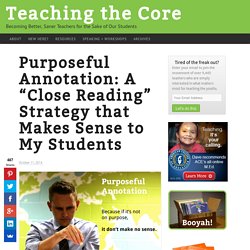

Modeling Close Reading for Future Teachers: ELA Videos and Webinars. In my previous post, I shared how I use freely available video in my reading and literacy methods course to help my preservice teachers (PTs) understand close reading instruction at a level that could not be attained through reading and discussion alone.

Below is my curated collection of videos for general Common Core info, as well as videos to teach the close reading, text complexity and informational texts standards. General Information About the Common Core 1. Common Core State Standards for ELA and Literacy This 15-minute video gives a general overview of the CCSS and explains why the U.S. has moved to the Common Core. 2. This is a set of cartoon drawings that explain the different organizations and institutions involved in developing the CCSS. 3. This eight-minute video provides an opportunity for teacher educators to hear from the two individuals who are most responsible for the CCSS -- David Coleman and Sue Pimentel.
Close Reading 4. In this three-minute video, Dr. 5. 6. 7. 8. Purposeful Annotation: A "Close Reading" Strategy that Makes Sense. Mmm… tortilla chip crumbs.

(It’ll make sense later.) If you look at my original close reading post, you’ll see I was basically using the phrase “close reading” to refer to annotation. It took me a year or more to realize that I was saying one buzzwordy thing to mean a lot of explicit, less confusing things that readers do when grappling with a text. I blame my error on allowing myself to get sucked into the unfortunate vortex that was the buzzwordification of close reading. If you’re new to the blog though, keep in mind while I do try not to take the educational establishment too terribly seriously (instead opting to occasionally poke fun at us), when it comes to helping students flourish in the long-term, I’m dead serious. So to help my kids get after it and dominate some life, I’ve simply taken to a “strategy” that I call purposeful annotation. The big idea is this: what we do when reading should align with. Common Core Rubric Creation Tool.
Curriculum and Instruction / Rubrics. Test Guides for English Language Arts and Mathematics. The Board of Regents adopted the Common Core State Standards (CCSS) for English Language Arts & Literacy and Mathematics at its July 2010 meeting and incorporated New York-specific additions, creating the Common Core Learning Standards (CCLS), at its January 2011 meeting.

The adoption of the CCLS signaled the need for educators to shift instruction to prepare students in accordance with these new, rigorous standards. In order to best assess student learning of the CCLS, the Department developed and administered new Grades 3-8 Common Core English Language Arts and Mathematics Tests in 2013. The spring 2014 Grades 3-8 tests will continue to assess only the CCLS.
In an effort to provide educators with as much support as possible regarding the instructional and assessment shifts necessitated by the Common Core, the Department has prepared 2014 Test Guides for each subject and grade. Smarter Balanced Assessment Consortium. 50 Teaching and Lesson Plans that Rock 8/7. Write a Rap About the News of 2012. The Year in Rap: 2011 from Flocabulary Update: Winners have been declared!

Visit this post to read the work of four group winners, and six individual winners. And thank you again for participating. Open my copy of The New York Times- Suddenly I am feelin’ like Busta Rhymes! From Casey Anthony winning her case, to Charlie Sheen and his fall from grace. — The first four lines of one of the winning raps from our 2011 “Year in Rap” contest. Though this blog has only been around for a little over three years now, we’ve already developed some traditions, and one of our favorites is our December celebration of the year in news. Each year we publish an end-of-year news quiz and a list of retrospectives, along with ideas for teaching with them. Last year we added an instant classic to the mix: in partnership with Flocabulary, creators of the Week in Rap and the Year in Rap, we ran a contest inviting students to submit their own 2011 Year in Rap lyrics. 432 did, and we chose winners in January.